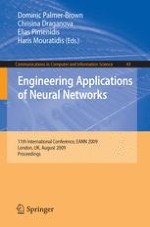A cursory glance at the table of contents of EANN 2009 reveals the am- ing range of neural network and related applications. A random but revealing sample includes: reducing urban concentration, entropy topography in epil- tic electroencephalography, phytoplanktonic species recognition, revealing the structure of childhood abdominal pain data, robot control, discriminating angry and happy facial expressions, ?ood forecasting, and assessing credit worthiness. The diverse nature of applications demonstrates the vitality of neural comp- ing and related soft computing approaches, and their relevance to many key contemporary technological challenges. It also illustrates the value of EANN in bringing together a broad spectrum of delegates from across the world to learn from each other’s related methods. Variations and extensions of many methods are well represented in the proceedings, ranging from support vector machines, fuzzy reasoning, and Bayesian methods to snap-drift and spiking neurons. This year EANN accepted approximately 40% of submitted papers for fu- length presentation at the conference. All members of the Program Committee were asked to participate in the reviewing process. The standard of submissions was high, according to the reviewers, who did an excellent job. The Program and Organizing Committees thank them. Approximately 20% of submitted - pers will be chosen, the best according to the reviews, to be extended and - viewedagainfor inclusionin a specialissueofthe journalNeural Computing and Applications. We hope that these proceedings will help to stimulate further research and development of new applications and modes of neural computing.
